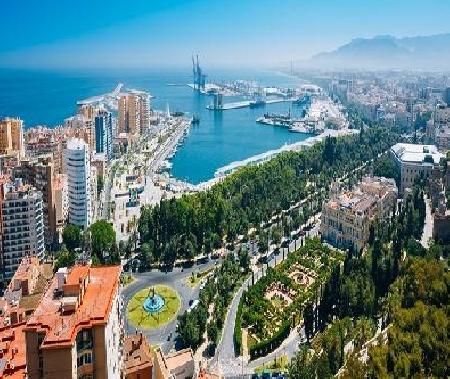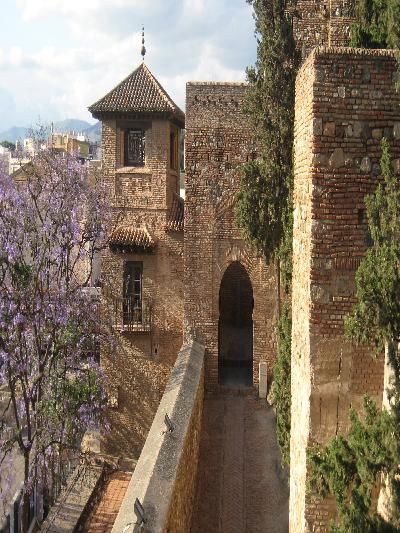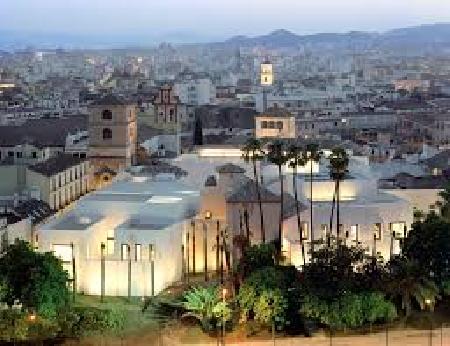 Málaga is a city and a municipality, capital of the Province of Málaga, in the Autonomous Community of Andalusia, Spain. With a population of 568,507 in 2010, it is the second most populous city of Andalusia and the sixth largest in Spain. The southernmost large city in Europe, it lies on the Costa del Sol (Coast of the Sun) of the Mediterranean, about 100 km (62.14 mi) east of the Strait of Gibraltar and about 130 km (80.78 mi) north of Africa.
Málaga is a city and a municipality, capital of the Province of Málaga, in the Autonomous Community of Andalusia, Spain. With a population of 568,507 in 2010, it is the second most populous city of Andalusia and the sixth largest in Spain. The southernmost large city in Europe, it lies on the Costa del Sol (Coast of the Sun) of the Mediterranean, about 100 km (62.14 mi) east of the Strait of Gibraltar and about 130 km (80.78 mi) north of Africa.
Málaga enjoys a subtropical–mediterranean climate. It has one of the warmest winters in Europe, with average temperatures of 17 °C (62.6 °F) during the day and 7–8 °C (45–46 °F) at night in the period from December through February. The summer season lasts about eight months, from April to November, although in the remaining four months temperatures sometimes reach around 20 °C (68.0 °F).
Málaga's history spans about 2,800 years, making it one of the oldest cities in the world. It was founded by the Phoenicians as Malaka about 770 BC, and from the 6th century BC was under the hegemony of Ancient Carthage. Then from 218 BC it was ruled by the Roman Republic and later the Roman Empire as Malaca (Latin). After the fall of the empire it was under Islamic domination as Mālaqah (مالقة) for 800 years, but in 1487 it again came under Christian rule in the Reconquista. The archaeological remains and monuments from the Phoenician, Roman, Arabic and Christian eras make the historic center of the city an "open museum", displaying its rich history of more than 3,000 years.
This important cultural infrastructure and the rich artistic heritage have culminated in the nomination of Málaga as a candidate for the 2016 European Capital of Culture.
The internationally acclaimed painter and sculptor Pablo Picasso and actor Antonio Banderas were born in Málaga. The magnum opus of Cuban composer Ernesto Lecuona, "Malagueña", is named for the music of this region of Spain.
The most important business sectors in Málaga are tourism, construction and technology services, but other sectors such as transportation and logistics are beginning to expand. The Andalusia Technology Park (PTA), located in Málaga, has enjoyed significant growth since its inauguration in 1992. Málaga is the main economic and financial centre of southern Spain, home of the region's largest bank, Unicaja, and the fourth-ranking city in economic activity in Spain behind Madrid, Barcelona and Valencia.
The Phoenicians from Tyre founded the city as Malaka about 770 BC. The name Malaka or mlk is probably derived from the Phoenician word for "salt" because fish was salted near the harbour. (Cf. "salt" in other Semitic languages, e.g. Hebrew מלח mélaḥ or Arabic ملح malaḥ).
After a period of Carthaginian rule, Malaka became part of the Roman Empire. In its Roman stage, the city (Latin name, Malaca) showed a remarkable degree of development. Transformed into a confederated city, it was under a special law, the Lex Flavia Malacitana. A Roman theatre was built at this time. After the fall of the Western Roman Empire, it was ruled first by the Visigoths and then by the Byzantine Empire (550–621).
In the 8th century, during the Muslim Arabic rule over Spain, the city became an important trade center. Málaga was first a possession of the Caliphate of Córdoba. After the fall of the Umayyad dynasty, it became the capital of a distinct kingdom ruled by the Zirids. During this time, the city was called Mālaqah (Arabic مالقة). From 1025 it was the capital of the autonomous Taifa of Málaga, until its conquest by the Emirate of Granada in 1239.
The traveller Ibn Battuta, who passed through around 1325, characterised it as "one of the largest and most beautiful towns of Andalusia [uniting] the conveniences of both sea and land, and is abundantly supplied with foodstuffs and fruits". He praised its grapes, figs, and almonds; "its ruby-coloured Murcian pomegranates have no equal in the world." Another exported product was its "excellent gilded pottery". The town's mosque was large and beautiful, with "exceptionally tall orange trees" in its courtyard.
Málaga was one of the Iberian cities where Muslim rule persisted the longest, having been part of the Emirate of Granada. While most other parts of the peninsula had already succumbed to the reconquista, the medieval Christian Spanish struggled to drive the Muslims out. Málaga was conquered by Christian forces on 18 August 1487, The Muslim inhabitants resisted assaults and artillery bombardments before hunger forced them to surrender, virtually the entire population was sold into slavery or given as "gifts" to other Christian rulers, five years before the fall of Granada. On 24 August 1704 the indecisive Battle of Malaga, the largest naval battle in the War of the Spanish Succession, took place in the sea south of Málaga.
Málaga had a period of rapid development in the 19th century, becoming with Barcelona one of the two most industrialised cities of Spain. But that early industry was gradually dismantled, because the successive national governments were supporting the industrial centers in the north of the country.After the coup of July 1936 the government of the Second Spanish Republic retained control of Málaga. Its harbour was a base of the Spanish Republican Navy at the beginning of the Spanish Civil War. It suffered heavy bombing by Italian warships which took part in breaking the Republican navy's blockade of Nationalist-held Spanish Morocco and took part in naval bombardment of Republican-held Malaga. After the Battle of Málaga and the Francoist takeover in February 1937, over seven thousand people were killed. The city also suffered shelling later by Spanish Republican naval units. The well-known British journalist and writer Arthur Koestler was captured by the Nationalist forces on their entry into Málaga, which formed the material for his book Spanish Testament. The first chapters of Spanish Testament include an eye-witness account of the 1937 fall of Málaga to Francisco Franco's armies during the Spanish Civil War. After the war, Málaga and Koestler's old haunts of Torremolinos and the rest of the Costa del Sol enjoyed the highest growth of the tourism sector in Spain.
Málaga is located in southern Spain, on the Costa del Sol (Coast of the Sun) on the northern side of the Mediterranean Sea. It lies at the feet of the Montes de Málaga, about 100 kilometres (62 miles) east of the Strait of Gibraltar and about 130 kilometres (81 miles) east of Tarifa (the southernmost point of continental Europe) and about 130 km (81 miles) on north of Africa. Lies on a similar latitude (36°N) as Algiers in Algeria, Tunis in Tunisia, Aleppo in Syria, Mosul in Iraq, Tehran in Iran, Kunduz in Afghanistan and Fresno, California in the United States.
Málaga, together with the following adjacent towns and municipalities: Rincón de la Victoria, Torremolinos, Benalmádena, Fuengirola, Alhaurín de la Torre, Mijas, Marbella and San Pedro Alcántara form the urban area with a population of 1,066,532 on 827.33 square kilometres (319.43 sq mi) (density 1,289 hab / km²) – 2012 data. The urban area stretches mostly along a narrow strip of coastline. The Málaga metropolitan area includes additional municipalities located mostly in the mountains area north of the coast and also some on the coast: Cártama, Pizarra, Coín, Monda, Ojén, Alhaurín el Grande and Estepona on west; Casabermeja on north; Totalán, Algarrobo, Torrox and Vélez-Málaga eastward from Málaga.
Municipalities of the metropolitan area are connected by the road network (including motorways) with the urban area and Málaga city (the urban area can be reached by car from the farthest reaches in 20 minutes and Málaga city in 45 minutes). In some usages the metropolitan area includes other municipalities to which Málaga's public transportation network extends, at least since the establishment of the Consorcio de Transporte Metropolitano del Área de Málaga (en: Consortium of Transportation of Málaga Metropolitan Area). Together about 1.3 million (max. 1.6 million) people live in the Málaga metropolitan area and the number grows every year as all the municipalities and cities of the area record an annual increase in population.
The climate is Mediterranean (Köppen climate classification: Csa) with very mild winters and hot summers. Málaga enjoys plenty of sunshine throughout the year, with an average of about 300 days of sunshine and only about 50 days with precipitation annually. Its coastal location with winds blowing from the Mediterranean Sea make the heat manageable during the summer.
Málaga experiences the warmest winters of any European city with a population over 500,000 and over 100,000 jointly with two other cities in Spain: Almería and Alicante. The average temperature during the day in the period December through February is 17–18 °C (63–64 °F). During the winter, the Málaga Mountains (Montes de Málaga) block out the cold weather from the north. Generally, the summer season lasts about eight months, from April to November, although in the remaining four months temperatures sometimes reach around 20 °C (68 °F). Its average annual temperature is 23 °C (73 °F) during the day (one of the highest in Europe) and 13 °C (55 °F) at night. In the coldest month, January, the temperature ranges from 12 to 20 °C (54 to 68 °F) during the day, 4 to 13 °C (39 to 55 °F) at night and the average sea temperature is 15–16 °C (59–61 °F). In the warmest month, August, the temperature ranges from 26 to 35 °C (79 to 95 °F) during the day, above 20 °C (68 °F) at night and the average sea temperature is 23 °C (73 °F).
Large fluctuations in temperature are rare. The highest temperature ever recorded during the day in the city centre is 43.3 °C (109.9 °F) on 13 August 1881. In the month of August 1881, the average reported daytime maximum temperature was a record 34.8 °C (94.6 °F). The coldest temperature ever recorded was −0.9 °C (30.4 °F) on the night (the same as tropical Miami) of 19 January 1891. The highest wind speed ever recorded was on 16 July 1980, measuring 119 km/h (73.94 mph). Málaga city has once recorded snow in the 20th century, on 2 February 1954.
Annual average relative humidity is 66%, ranging from 59% in June to 73% in December. Yearly sunshine hours is between 2,800 and 3,000 per year, from 5–6 hours of sunshine / day in December to average 11 hours of sunshine / day in July. This is one of the highest results in Europe and almost double more that of cities in the northern half of Europe (for comparison: London – 1,461, Warsaw – 1,571, Paris – 1,630). According to the Instituto Nacional de Estadística, 2007 saw 3,059 hours of sunshine. Rain occurs mainly in winter, with summer being generally dry. Málaga is one of the few cities in Europe which are "green" all year round.

Main sights :
The old historic centre of Málaga reaches the harbour to the south and is surrounded by mountains to the north, the Montes de Málaga (part of Baetic Cordillera), lying in the southern base of the Axarquía hills, and two rivers, the Guadalmedina – the historic center is located on its left bank – and the Guadalhorce, which flows west of the city into the Mediterranean. The oldest architectural remains in the city are the walls of the Phoenician city, which are visible in the cellar of the Museo Picasso Málaga. The Roman theatre of Málaga, which dates from the 1st century BC, was fortuitously rediscovered in 1951. The Moors left posterity the dominating presence of the Castle of Gibralfaro, which is connected to the Alcazaba, the lower fortress and royal residence. Both were built during the Taifa period (11th century) and extended during the Nasrid period (13th and 14th centuries). The Alcazaba stands on a hill within the city. Originally, it defended the city from the incursions of pirates. Later, in the 11th century, it was completely rebuilt by the Hammudid dynasty. Occupying the eastern hillside that rises from the sea and overlooks the city, the Alcazaba was surrounded by palms and pine trees.
Like many of the military fortifications that were constructed in Islamic Spain, the Alcazaba of Málaga featured a quadrangular plan. It was protected by an outer and inner wall, both supported by rectangular towers, between which a covered walkway led up the slope to the Gibralfaro (this was the only exchange between the two sites). Due to its rough and awkward hillside topography, corridors throughout the site provided a means of communications for administrative and defensive operations, also affording privacy to the palatial residential quarters.
The entrance of the complex featured a grand tower that led into a sophisticated double bent entrance. After passing through several gates, open yards with beautiful gardens of pine and eucalyptus trees, and the inner wall through the Puerta de Granada, one finds the 11th and 14th century Governor's palace. It was organised around a central rectangular courtyard with a triple-arched gateway and some of the rooms have been preserved to this day. An open 11th century mirador (belvedere) to the south of this area affords views of the gardens and sea below. Measuring 2.5 square metres, this small structure highlighted scalloped, five-lobed arches. To the north of this area were a waterwheel and a Cyclopean well (penetrating forty metres below ground), a hammam, workshops and the monumental Puerta de la Torre del Homenaje, the northernmost point of the inner walls. Directly beyond was the passage to the Gibralfaro above.
The Church of Santiago (Saint James) is an example of Gothic vernacular Mudéjar, the hybrid style that evolved after the Reconquista incorporating elements from both Christian and Islamic tradition. Also from the period is the Iglesia del Sagrario, which was built on the site of the old mosque immediately after the city fell to Christian troops. It boasts a richly ornamented portal in the Isabeline-Gothic style, unique in the city.
The Cathedral and the Episcopal Palace were planned with Renaissance architectural ideals but there was a shortfall of building funds and they were finished in Baroque style. The Basílica y Real Santuario de Santa María de la Victoria, built in the late 17th century, has a chapel in which the vertical volume is filled with elaborate Baroque plasterwork. Other sights include:
• Walls. Phoenician, Roman, Byzantine, Arab and Spanish remains of the defensive compounds of the city.
• La Concepción, botanical and historical garden.
• Church of the Sacred Heart.
• San Felipe Neri Church.
• Church of the Holy Martyrs.
• Atarazanas Market.
• Palm grove and Muelle Uno. Port of Málaga.
• Anglican Cemetery of St. George.
• San Miguel Cemetery.
• La Malagueta bullring.
• Pedregalejo, old fishing district.
Museums
• Museo Picasso Málaga, located at the Palacio de los Condes de Buenavista.
• Museo Carmen Thyssen, located at Palacio de Villalón.
• Museo de Málaga (Fine Arts and Archeology museum) at the Palacio de la Aduana.
• CAC Málaga (museum of modern art). The most visited museum in Andalusia.
• Fundación Picasso and Picasso Birthplace Museum.
• City museum (MUPAM).
• Automobile Museum of Málaga.
• Museum of Glass and Crystal.
• Museo Interactivo de la Música (MIMMA).
• Museum of Wine.
• Museo de Artes y Tradiciones Populares. Museum of Arts and Popular Traditions.

Málaga is the fourth-ranking city in economic activity in Spain behind Madrid, Barcelona and Valencia. The most important business sectors in Málaga are tourism, construction and technology services, but other sectors such as transportation and logistics are beginning to expand. The Andalusia Technology Park (PTA) (In Spanish, "Parque Tecnológico de Andalucía"), located in Málaga, has enjoyed significant growth since its inauguration in 1992 by the King of Spain. As of 2010, this high-tech, science and industrial park is home to 509 companies and employs over 14,500 people.
In line with the city's strategic plan, the campaign "Málaga: Open for Business" is directed towards the international promotion of the city on all levels but fundamentally on a business level. The campaign places a special emphasis on new technologies as well as innovation and research in order to promote the city as a reference and focal point for many global business initiatives and projects. Málaga is a city of commerce and tourism has been a growing source of revenue, driven by the presence of a major airport, the improvement of communications, and new infrastructure such as the AVE and the maritime station, and new cultural facilities such as the Picasso Museum, the Contemporary Art Centre and Trade Fair and Congress, which have drawn more tourists.
The city hosts the International Association of Science and Technology Parks (IASP) (Asociación Internacional de Parques Tecnológicos), and a group of IT company executives and business leaders has launched an information sector initiative, Málaga Valley e-27, which seeks to make Málaga the Silicon Valley of Europe. Málaga has had strong growth in new technology industries, mainly located in the Technological Park of Andalusia, and in the construction sector. The city is home to the largest bank in Andalusia, Unicaja, and such local companies as Mayoral, Charanga, Sando, Vera, Ubago, Isofoton, Tedial, Novasoft, Grupo Vértice and Almeida viajes, and other multinationals such as Fujitsu Spain, Pernod Ricard Spain, Accenture, Epcos, Oracle Corporation, Huawei and San Miguel.
